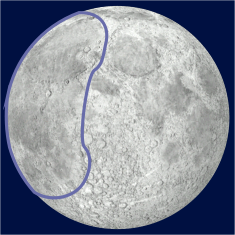| Feature on | The Moon | | Feature type | Mare (lunar sea) | | Quadrangles | Primarily LQ-10, but extending through LQ-03, LQ-04, LQ-11, LQ-18 and LQ-19 | | Lunar coordinates | 50° N - 13° S, 30 - 85° W
(The boundaries of this feature are not always distinct, especially on its eastern edge, so these coordinates are approximate) | | Dimensions | Area c.2,100,000 sq km | | Bounding features | Copernicus, Hevelius, Letronne, Mare Cognitum, Mare Humorum, Mare Imbrium, Mare Nubium, Montes Carpatus, Montes Riphaeus, Sinus Roris | | Significant interior features | Aristarchus, Herodotus, Kepler, Planitia Descensus, Vallis Schröteri | | Other interior features | Angström, Bessarion, Brayley, Briggs, Cardanus, Dechen, Eddington, Euclides, Flamsteed, Freud, Galilaei, Hansteen, Harding, Herigonius, Hermann, Hortensius, Humason, Krieger, Kunowsky, Maestlin, Marius, Lichtenberg, Milichius, Montes Harbinger, Naumann, Nielsen, Reiner, Rima Cardanus, Rima Marius, Rimae Aristarchus, Rümker, Russell, Schiaparelli, Seleucus, Struve, Suess, Ulugh Beigh, Väisälä, Wichmann, Wollaston, Zinner | | Notes | The largest of the Moon's seas, and the only one classified as an 'ocean', covers an area of more than two million square kilometres, greater than that of the Gulf of Mexico on Earth. |


A vast grey plain in the Moon's western hemisphere. Its appearance on the Moon's face during the second quarter was thought to herald bad weather, hence its name. Around its edges are numerous minor seas and bays, of which the largest is the southern Mare Nubium, the Sea of Clouds. Its northern edge is defined by the line of the Carparthian Mountains, which separate it from the huge Mare Imbrium.
Origins
Like the other lunar maria or seas, the Ocean of Storms is a flat field of basalt formed by hardening of magma (indeed this region is not structurally different from the Moon's other seas - its differentiation as an 'ocean' rather than a 'sea' is due solely to its extraordinary size). Most of the other seas have an approximately circular aspect, showing that they can be linked to bombardment of the lunar surface early in the Moon's existence. Oceanus Procellarum may have been formed in the same way, but if so the impact that created it must have been truly immense.
There are various other hypotheses for the creation of the Ocean offering alternatives to the impact idea. Perhaps most plausibly this huge area may have been subject to forces within the Moon's early structure that caused magma to flow freely across great swathes of its western hemisphere before solidifying to create the flat surface of the plain.
Features

The largest of the Moon's maria or 'seas', Oceanus Procellarum extends across a significant proportion of the western hemisphere of the Moon's visible face.

The ruined crater of Letronne on the southern shores of Oceanus Procellarum. The lava of the Ocean plain has flowed into the ancient crater, creating a 'bay' in the surrounding highlands, with the remnant of the crater's central peak forming a cluster of hills in its centre.
For all its immense size, the interior surface of Oceanus Procellarum is generally featureless apart from a peppering of small craters. The most significant exception is Kepler, a rayed crater some 32 km in diameter near the centre of the Ocean. Two other relatively large craters are also to be found in the Ocean's interior: Encke, near Kepler to the south, and Marius, some distance away from Kepler to the west.
Around the margins of the Ocean are a host of more prominent surface features. On a plateau near its northern shores, in the direction of Sinus Roris, the Bay of Dew, is another rayed crater. This is Aristarchus, comparable in size to Kepler and one of the brightest individual features on the Moon. Eastward from Aristarchus, Oceanus Procellarum meets Mare Imbrium, the wide Sea of Rains, and part of their mutual border is marked by a mountain range, the Montes Carpatus or Carpathian Mountains. Southward from these mountains lies the immense terraced crater known as Copernicus, stretching for nearly a hundred kilometres from side to side.
Southward from Copernicus, forming the southeastern limits of the Ocean of Storms, runs the highland ridge of Montes Riphaeus, separating the Ocean from Mare Cognitum. This region had been considered an outlier of the Ocean itself, but in 1964 it became the first part of the Moon to be seen in detail by a probe from Earth, and after this time it was given its own designation Mare Cognitum, meaning the 'Known Sea'.
Southward and westward from Mare Cognitum lie two further small seas extending out from the main ocean: Mare Nubium, the Sea of Clouds, and Mare Humorum, the Sea of Moisture. Westward from these the limits of Oceanus Procellarum become more distinct, so that its southwestern edge is well defined by a range of highlands, and as these highlands run northward they reach a point near the Moon's western limb. There, on the western visible extent of Oceanus Procellarum, lies a small valley. It was in this valley in 1966 that the first probe from Earth - Luna 9 - made a successful soft landing on the Moon, and the valley is known as Planitia Descensus, the Plain of Descent, in recognition of this achievement.
|
|